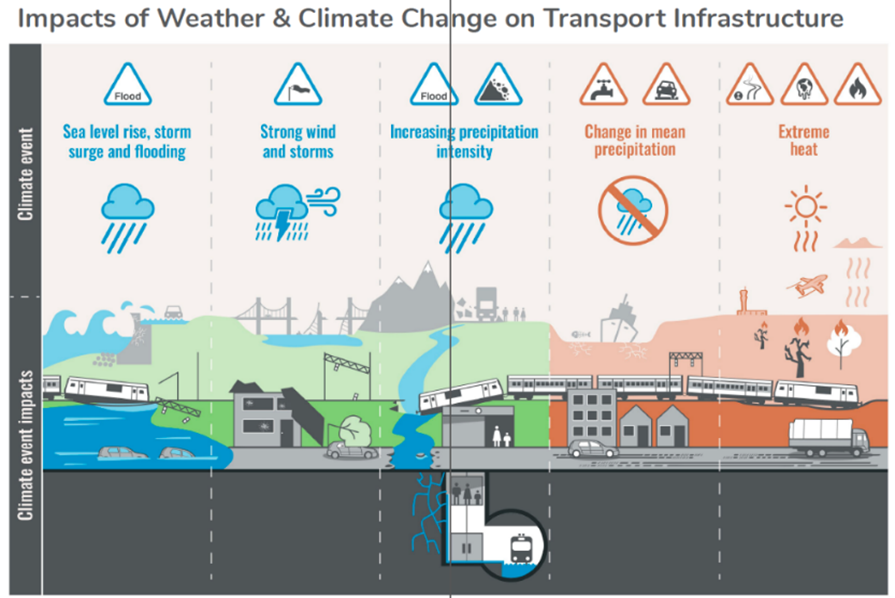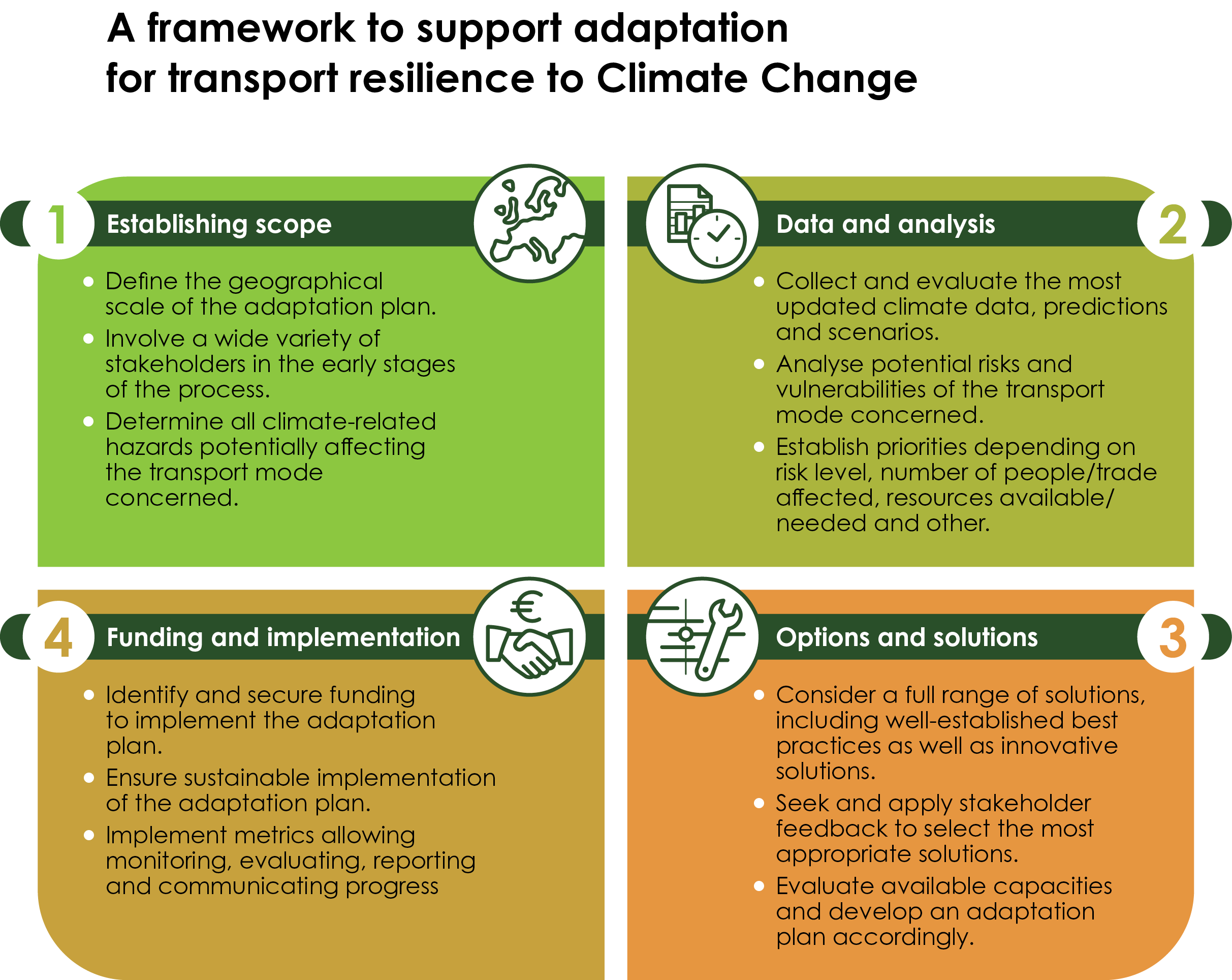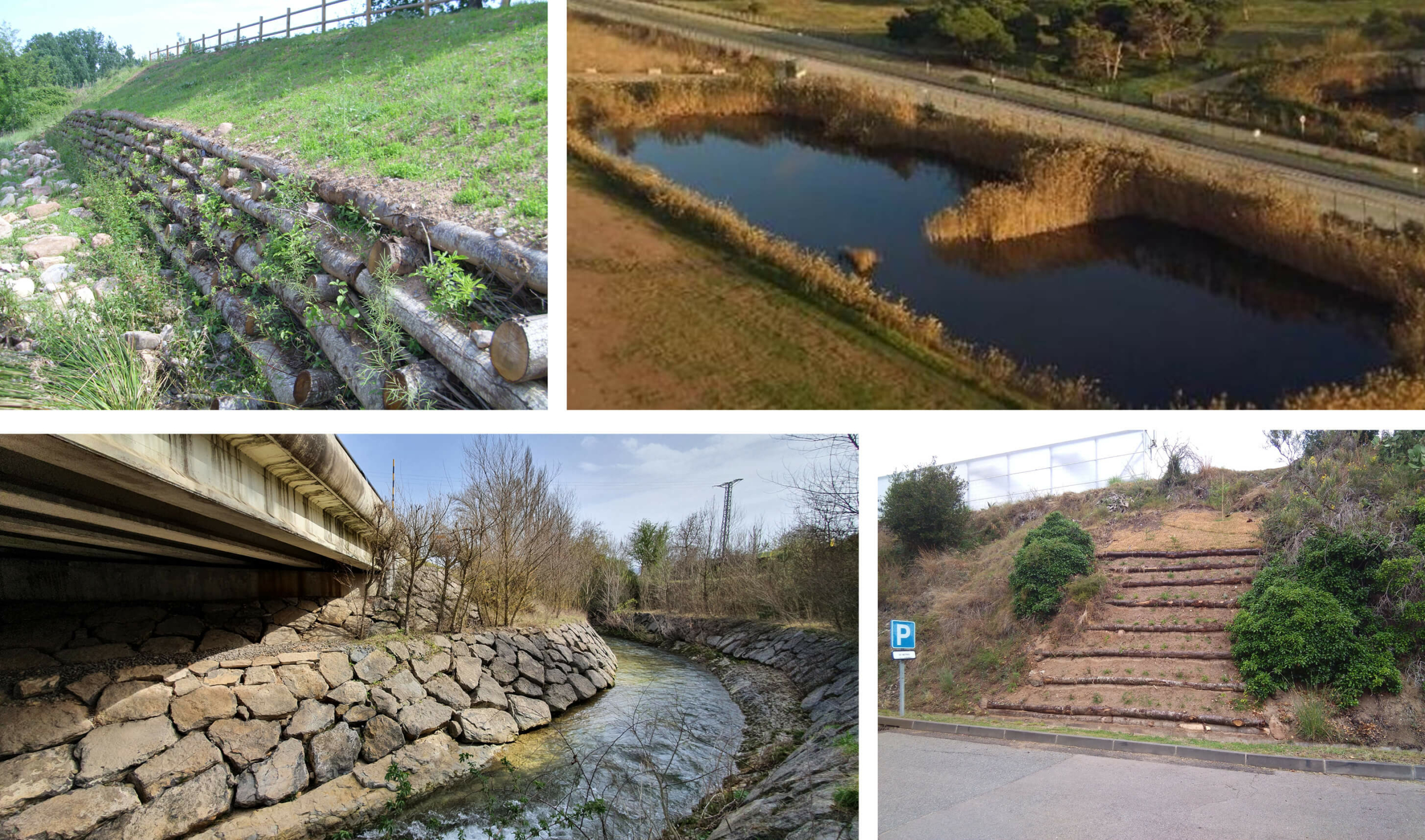RATIONALE. Adaptation of infrastructure to climate change
The transport sector is one of the main contributors to climate change, emitting up to 15% of greenhouse gases in 2019 (IPCC, 2023). At the same time, transport infrastructure is increasingly impacted by the effects of climate change, which cause service disruptions and economic losses (Palin et al., 2019; Greenham et al., 2020; Thacker et al., 2021; Seiler et al., 2023).
In Europe, policies to tackle this threat are two-fold. On one hand, the European Green Deal and the European Climate Law, with the ‘Fit for 55 package’, aim for a reduction of 55% in greenhouse emissions by 2030 and to be climate neutral by 2050 (EC, 2019; 2021). On the other hand, the EU Strategy on Adaptation to Climate Change, highlights the urgency of acting to increase the resilience of transport infrastructure against climate-related hazards, which are already occurring (EC, 2021a).
Transport operators, agencies and associations are developing climate change adaptation frameworks and plans to implement adaptation measures (PIARC 2023; 2023a). However, in many instances, the measures being considered are based on traditional grey solutions (Payne et al., 2018; Palin et al., 2021), rather than those aimed at achieving environmental, social and economic co-benefits, for example benefits that arise from the implementation of Nature-based Solutions (IUCN, 2016; Seiler et al., 2023). This section is focused on how measures implemented to adapt transport infrastructure to climate change could also benefit biodiversity.
Climate change is one of the main challenges societies are facing worldwide. Climate change has substantial impacts on infrastructure jeopardizing its operation, performance and resilience. The effects have been accelerating in recent decades. Countermeasures that can be applied intended to:
- ‘mitigate’ climate change, mainly by reducing emissions and achieving climate neutrality for the transport sector.
- ‘adapt’ to climate change by reducing its impacts on transport infrastructure and achieving climate resilience.
Measures to fight the effects of climate change can contribute to the development of a more sustainable, safer and resilient transport infrastructure, and create opportunities to reduce biodiversity loss. On the other hand, inappropriate measures may further harm biodiversity. One example is the deployment of renewable energy installations such as photovoltaic parks and wind turbines that have become additional fragmentation elements in the landscape, also strengthening the impacts along infrastructure corridors. These installations may have serious impacts on biodiversity that need to be addressed by careful planning, design, construction and operation. The knowledge from decades of practice in the framework of transport ecology can inform and assist such development, benefitting both biodiversity and people.
Climate-related hazards, including strong wind, storms, flooding, landslides or extreme temperatures, all have significant impacts on transport infrastructure (Figure 5.9.1). Adaptation of infrastructure to climate change is vital for Europe´s societies and economies. It requires substantial investment and broad application of robust knowledge to create a climate-resilient infrastructure. Infrastructure Adaptation Plans aimed at upgrading and adapting infrastructure to reduce the effects of climate change are currently being developed by transport operators from all over Europe.
Adopting a comprehensive approach to climate change adaptation, which takes into account the effects of climate change and its impacts on biodiversity, will help to identify synergistic actions, i.e., the implementation of Nature-based Solutions (NbS). This enhances cost-effectiveness and provides benefits to people and biodiversity. This transversal cross-cutting approach should be incorporated into all Infrastructure Climate Change Adaptation Plans, maintenance practices for existing transport networks and the planning and design of new infrastructure.
This section focuses on measures applied to adapt transport infrastructure aiming to reduce climate change effects (see list in Table 5.12). Specifically, it explores the opportunities that infrastructure adaptation offers for mainstreaming biodiversity in transport infrastructure.
Table 5.12 – Summary of measures for climate change adaptation addressed in this section.
| Climate-relate hazards | Adaptation measures |
| General | Risk and vulnerability assessments |
| Early Warning Systems (EWS) | |
| Floods | Create or increase the size of water retention ponds |
| Increase the size of culverts and other transversal drainages | |
| Increase water infiltration and retention by using green ditches | |
| Adapted drainage maintenance plans | |
| Forest fires | Infrastructure verge design and maintenance |
| Adapted management of green areas | |
| Cooperation on forest fire prevention plans Monitoring | |
| Wind | Undergrounding parts of the infrastructure (e.g. powerlines) |
| Landslides | Green engineering applied to verge stabilisation and habitat restoration |
| Increase water infiltration and retention by using green ditches | |
| Droughts | Adaptation of green area vegetation and maintenance + Soil stabilisation |
| Sea-level rise | Habitat restoration |
| ‘Green’ retaining dykes | |
| Spread of pathogens and pests | Use of non-toxic control methods |
| Frost | Application of sustainable de-icers which reduce negative impacts on biodiversity |
Establishing a framework to improve transport resilience is crucial. This involves engaging different stakeholders at different phases of the infrastructure life cycle. Such an approach is vital for improving coordination among stakeholders and for increasing capacity and knowledge regarding infrastructure adaptation (Figure 5.9.2). In this process:
- Risk and vulnerability analyses should be conducted for both new and existing infrastructure. Due to the high levels of uncertainty related to climate change scenarios, these analyses should be periodically updated with the most up-to-date and reliable information. In Europe, the Climate-Adapt Platform, developed by the European Commission, provides resources to support decision-makers from different sectors, including transport.
- Decision-making criteria, indicators and thresholds that require the implementation of adaptation measures should be established to ensure that decisions are based on the best information available.
- Funding plays a key role in creating a functional framework for resilient infrastructure. Public funding should integrate resilience and biodiversity criteria into procurement processes. This can be achieved, for example, by estimating the economic savings that adaptation measures to mainstream biodiversity will yield from specific projects. This mechanism could simultaneously mobilise private funding towards investments in resilient, sustainable infrastructure.
- Evaluation and monitoring of adaptation measures, and the adaptation process itself, are vital to avoid poor adaptation outcomes (‘maladaptation’). Continuous evaluation and a flexible and adaptive management scheme will refine both the measures and the process if climatic projections change. These tasks should be undertaken in cooperation between infrastructure and environmental stakeholders.
Risk and vulnerability assessments
The first step in adapting infrastructure to climate change is to assess the climate risks it faces. This helps to avoid high-risk areas when building new infrastructure and to prioritize locations for specific adaptation actions on existing infrastructure.
Specific methodologies and approaches will depend on transport mode, purpose, resources, and many other variables. ISO 14091 provides some guidelines for the development and implementation of present and future climate risk assessments. However it is critical also to include biodiversity and landscape ecological considerations.
The main aspects in development of risk assessments are:
- Be performed for all foreseeable or the most probable climate-related hazards in the analysed area. Although uncertainty is an important handicap in climate change adaptation, a comprehensive risk analysis should cover plausible scenarios at the very least.
- Incorporate information on climate hazards, exposure and vulnerability of infrastructure assets, as well as on wildlife populations at risk and the potential environmental damage due to this vulnerability. For example, to evaluate the risk of road flooding, the projected rainfall in the area, the topography of the road surroundings and the presence and capacity of drainage systems should be considered.
- Include assessments at landscape scale, considering the relationships between infrastructure and ecosystems at a broader scale.
- Conduct assessments at transport network scale to incorporate routes that may be an alternative to carry traffic in cases of disruption. Rerouting should evaluate potential impacts on biodiversity for substitute infrastructure and implementing corresponding mitigation measures for at least the period of substitution should be considered.
- Include the evaluation of risks to wildlife and impacts on ecosystems from different scenarios and applied countermeasures. Reducing any risk of biodiversity loss must be an essential criterion. Ecological corridors must be preserved and restored as they are essential for allowing biodiversity to adapt to climate change. Thus, assessments must include biodiversity topics such as ecological connectivity, shifting ranges of target species, trends on target species population sizes and others according to the specific circumstances.
- Incorporate a socio-economic dimension to evaluate the magnitude of a potential disruption.
- Summarize the information in the form of risk and vulnerability maps which can be used at different levels, from policy-makers to infrastructure and biodiversity managers.
Once the risks have been identified and assessed, the most appropriate solutions can be implemented. In some cases, these will involve structural measures, like increasing culvert size or replacing it with an adapted viaduct, which at the same time will tackle the infrastructure barrier effect for wildlife. Others, measures may include management strategies, such as planting low flammability species in areas with high risk of fire. In general, these solutions should:
- Be ‘effective, feasible, and just means of reducing climate risk, increasing resilience, and pursuing other climate-related societal goals’ as it was established by the IPPC in 2022.
- Incorporate biodiversity conservation goals.
- Prioritize Nature-based Solutions over traditional technical solutions based on the use of concrete, metal or other inert materials.
- Be monitored and evaluated, following criteria including environmental, social and economic parameters.
- Adopt a flexible and adaptive approach to be able to deal with the uncertainties that climatic, ecological, and socio-economic projections involve.
Early Warning Systems (EWS)
One of the key tools used in adaptation to reduce damage caused by climate-related hazards are Early Warning Systems (EWS). These are procedures which involve detection and analysis of hazards (often by continuous data recording and evaluation) and fast decision-making processes to mitigate them. They are better developed at national or regional level and in areas where extreme events are common. Some transport agencies have already implemented EWS on their networks.
This approach has also been proposed for or implemented in other relevant areas, such as detection and control of Invasive Alien Species, pest management, or preventing spread of diseases. Taking advantage of digitalization within the transport and biodiversity sectors and the expected implementation of sensors, EWS procedures will become comprehensive tools to register and evaluate key indicators providing information about new impacts related to climate change effects.
Nature-based Solutions (NbS) for climate change adaptation
NbS present a range of comprehensive and integrative approaches to adapt infrastructure to climate change, addressing risk reduction and enhancing benefits for biodiversity and people. These measures can be applied at local scales (e.g. green engineering to stabilize embankments or green drainages) but they can also be applied in surrounding landscapes. A successful application of NbS requires a landscape approach that:
- provides a sustainable and cost-effective alternative to traditional ‘grey’ alternatives, which are based on the use of concrete, metal or other artificial materials;
- is flexible, allowing an adaptive management;
- is itself adaptable, since natural ecosystems are inherently adaptable and subject to local conditions;
- promotes an inclusive governance approach, including diverse stakeholders and users;
- facilitates the achievement of biodiversity Net Gain and enhances positive effects, rather than just addressing negative impacts.
There is a wide variety of actions that could be defined as NbS (Figure 5.9.3) and their categorisation is not considered in detail in this section, although some of them have been outlined in following sections and in relation with specific climate-related hazards. However, there are some general considerations which are important when designing this type of solutions to adapt infrastructure to climate-related hazards:
- NbS should be designed by interdisciplinary teams, involving scientific evidence-base information as well as practitioners’ knowledge.
- Evaluation of NbS functionality and benefits to biodiversity and infrastructure should be evaluated and comparison with ‘grey’ solutions must be undertaken to identify the solution providing a better cost-effectiveness ratio. Often both ‘grey’ and ‘green’ solutions can be combined.
- Priority should be given to NbS allowing to protect natural habitats and valuable ecosystems, and to restore degraded ecosystems.
- Ecological engineering techniques allow to use vegetation and ecosystem to develop resilient green and blue areas associated to infrastructure which will allow a better adaptation to risk related to climate change. A wide variety of innovative methods and materials may be applied.
- The scale of implementation depends on specific climate-related hazards, mode of transport and other factors, but it should be as wide as possible.
- Appropriate indicators and evaluation methods to assess the effectiveness of NbS and its benefits are still needed to encourage the use of NbS among practitioners and investors. Establishing project specific indicators and ensuring appropriate monitoring would help to advance this important method.


